Post-Music: Apocalypse Soundcheck
|Y7
In March 2023, music blogger @billdifferen re-posted a series of videos to (then) Twitter of sound system clashes in India. The videos in the thread usually involved two or more mobile sound systems competing with each other by blasting sparse, austere tracks of sweeping bass tones and alarm sounds at what seems to be ear-splitting volumes. Unlike sound system culture closer to its Jamaican roots, there is apparently no need to wait your turn in India: sound systems blare noise at each other simultaneously, with revelers often sandwiching themselves in the crossfire.
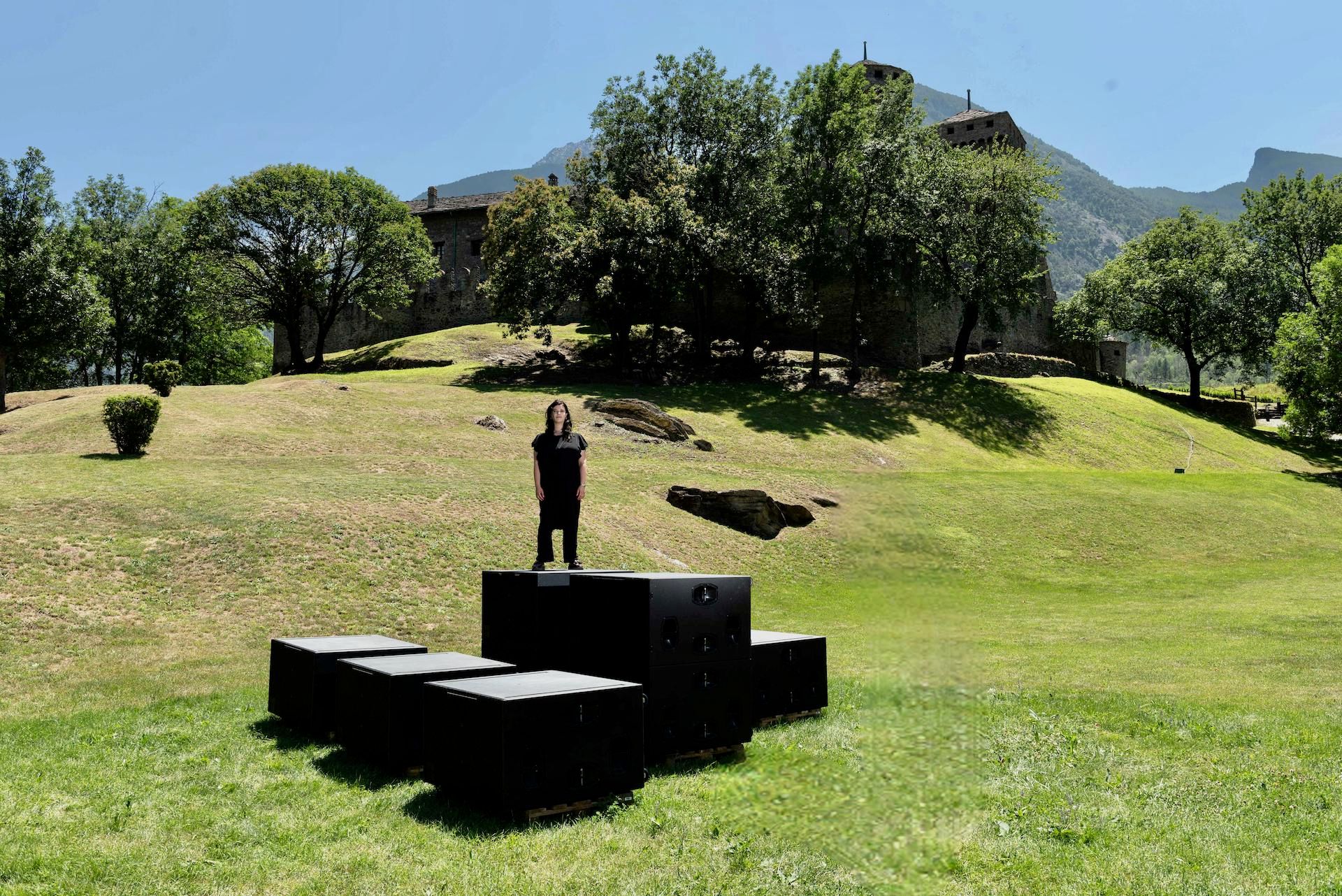
Fast-forward to September 2023 and our TikTok feed threw up a video from user @samrolfes of a sound art performance with the caption “Stefanie Egedy’s insane bass compositions on the High Line literally caused a NYFW evacuation” alongside a screenshot of a news story from Page Six with the headline “Alice + Olivia staff evacuate as building shakes during Fashion Week prep.” Both the video and audio of the footage (much like the footage of the Indian sound systems) repeatedly distort as the decibel levels exceed the threshold of the phone’s internal microphone and cause blurring through sheer vibrational force.
During the six months between these two videos, we had kept a loose track of the sound system clashes, which are associated with a few different terms or names: “soundcheck competitions,” “music box competitions,” and “power music” being the stand-outs. We had also begun to notice similarly outlandish tendencies emerging elsewhere in contemporary music, which gravitated towards an increasingly caricatured sensibility where the hallmarks of styles were so exaggerated that they seemed fictive (of late, DJ Ramon Succeso, Lil Yachty, Crunk Boyz, AGUSFORTNITE2008, and Tropa dos 01 - 2.0 spring to mind). Aspects of this pattern have been touched on very recently by writer Kieran Press-Reynolds, who has diagnosed a musical landscape dominated by a style he terms Shitpost Modernism.
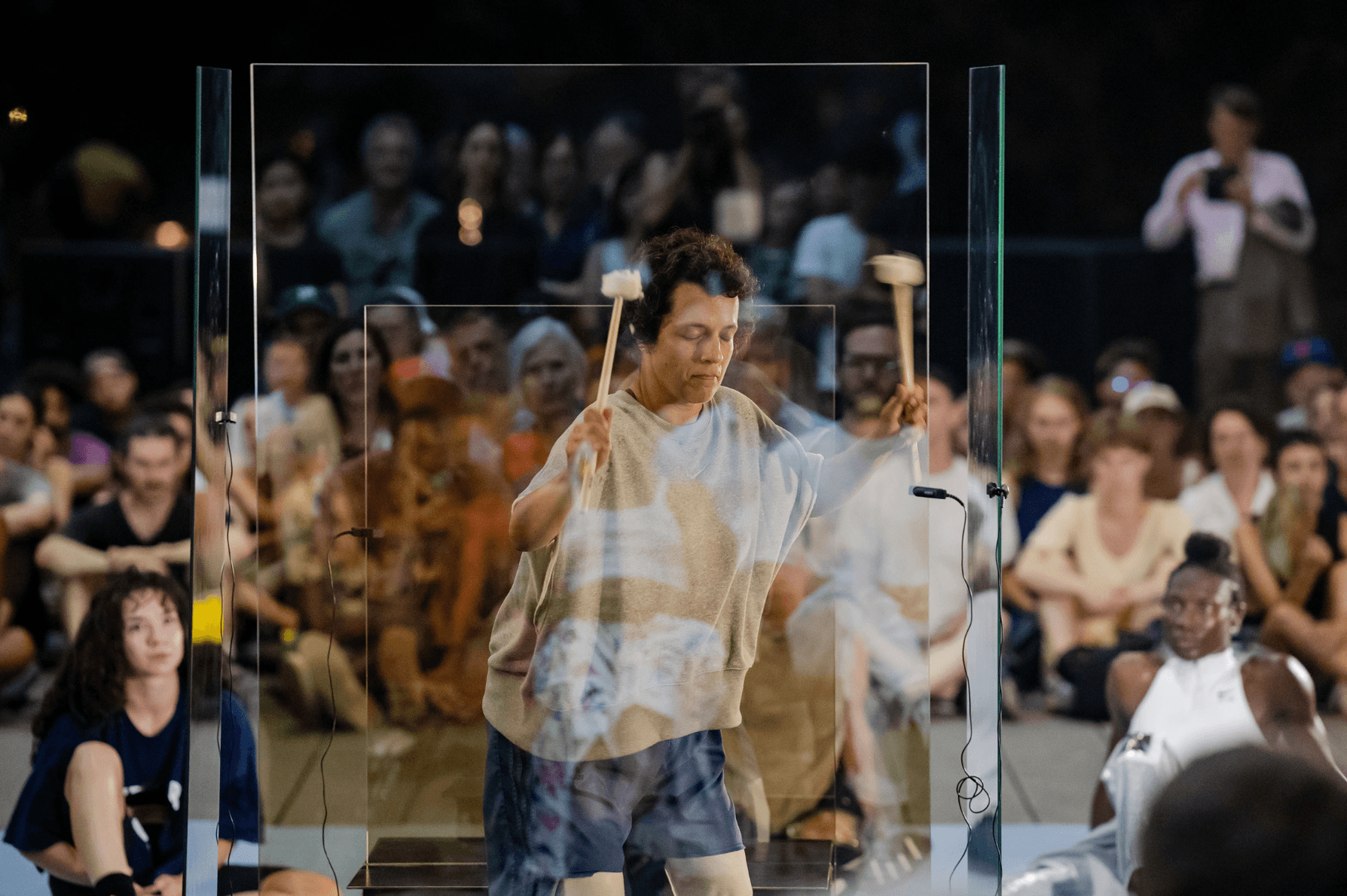
We began to wonder whether these trends might be indicative of wider shifts in emergent audio culture. As well as wanting to find out more about soundcheck competitions, which we were lucky enough to have illuminated for us by two incredibly generous researchers, we were also desperate to chat with Stefanie Egedy not only about her practice and the NYFW incident, but also about a question we’ve been asking ourselves lately: Are we entering an age of post-music?
The term “post-music” is used here somewhat tongue-in-cheek. It is as much a provocation or thought experiment as it is a serious attempt to map a nascent era, genre, or trend. It is not a claim that the output of any of the artist’s listed above do not qualify as music. Rather, it is a tracing of the trajectories of increasingly caricatured auditory niches (in part driven by a context of ever-accelerating trend cycles) to look at possible areas where practices could emerge that take place outside of the confines we collectively place around ideas of music.
While post-music has been a useful provocation to help steer our minds along potential trajectories of new cultural production, we could just as easily use alternating (although not interchangeable) terms like infra-music, ultra-music, or even unsound (defined by Steve Goodman in Sonic Warfare: Sound, Affect and the Ecology of Fear as “sounds not yet heard”). What is most important though, particularly in relation to soundcheck competitions and the work of Stefanie Egedy, is the imagining of a framework for sonic culture based not only on what sound sounds like, but what sounds feel like and, most importantly—to paraphrase Annie Goh—what sounds have the capacity to move.

…the body is a large brain that thinks and feels a sensational mathematics throughout the entire surface of its distributed mind. — Kodwo Eshun, More Brilliant Than the Sun: Adventures in Sonic Fiction.
One of the first things that stood out to us was the genre’s name. The term ‘soundcheck’ implies—and this is seemingly backed up by formal aspects of the audio—that the sounds being played are as much test tones as they are music. Sine wave bass sweeps, sirens, and alarms are the utilitarian foundations of the style; it’s about loudness and commanding attention. The central function of soundcheck tracks appears to be their capacity to demonstrate the sound systems’ prowess in the most literal and direct way possible. As the focal point of soundcheck is the IRL experience of the speakers, it is not a genre wholly compatible with popular forms of documentation or mediation. This is not to say that we can’t listen to soundcheck tracks through our headphones or watch videos of competitions and clashes on YouTube, but to acknowledge that doing so strips away the tactility the genre seems to be so acutely centered around.
In the supposedly smooth, frictionless space of digitally distributed music services, there is a tendency to treat music as something ephemeral and shorn of physicality: something transcendent. Soundcheck, however, is in opposition to this: generally, the tracks are not expressions of subjective interiority but rather stimulations of exteriority, of tactility. Take some examples of tracks by DJ Surajit Competition Over Bit Bass and DJ Sagar. It is hard to imagine these being listened to in a passive manner outside of their function within soundcheck. The audio does little beyond drawing attention to its own immediacy.
These tracks are one component in a circuitry of a physical practice. “Danger” (or “very danger”) is a mantra consistently repeated throughout soundcheck-related content, in what is presumably a reference to the extreme testing of the body’s capacity to endure the vibrational force of the sound systems. Further indications of soundcheck’s existence as a pursuit of adrenaline junkies can be found in the repeated usage of imagery (and sometimes even sounds) of crows, presumably owing to the fact that in Hindu culture the birds act as messengers between the living and their dead ancestors.
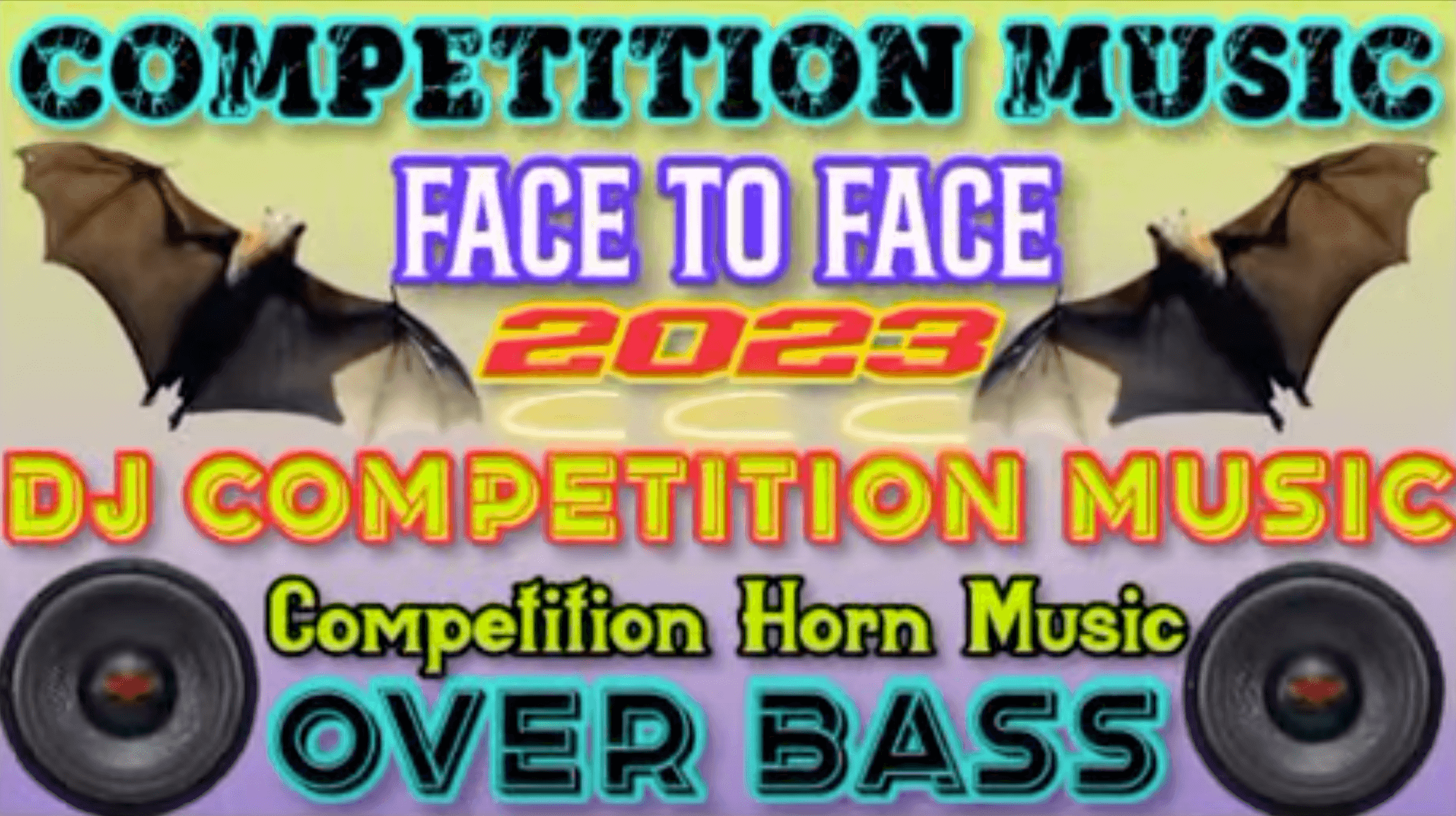

As previously mentioned, the sheer force of the sound systems cause distortion with mobile devices attempting to video them (alongside visibly warping surrounding buildings). Aside from being evidence of soundcheck’s current incompatibility with mediation, it is also elsewhere becoming something of a hallmark of authenticity. Since videos of him performing went viral, baile funk artist DJ Ramon Sucesso deliberately tailors his music to incorporate certain frequencies known to cause ruptures in visual documentation. When interviewed by Nathan Evans, he stated, “I’m quite [particular] about searching for kick sounds and samples and frequencies that will create the distortion effect and tremble the camera and work with my speakers.”
The extremity of soundcheck’s style—presumably a result of the escalatory race for supremacy between clashing systems—feels like one that may have already exhausted its capacities for progression. Where could one possibly go from waveform-maxing sine tones and alarms? There’s a tension between the eerie formal austerity of the tracks and the overwhelming ferocity with which they are deployed. Soundcheck here hints at a horseshoe theory of minimalism and maximalism where the logical conclusions of each extreme occupy a similarly flatlined sound. As we stated in our article on the TikTok micro-trend, #corecore: “you can, by accelerating the BPM of a drum loop through the 100s into the 1000s, pass through gabba and enter nirvana.”
There seems to be a similarly conclusory cultural logic at play in soundcheck as there was at the heart of #corecore, both of which drag the genres to the outer limits of plausibility. But we couldn’t help but associate soundcheck with a far more fundamental conclusion: the echoing of civil defense sirens and the conjuring of Cold War dread impressed on us a distinctly apocalyptic vibe. In fact, sound systems similar to those used in India were deployed in the Lautsprecherkrieg (Loudspeaker War) on either side of the Berlin Wall in the 1960s. There are notable similarities too between soundcheck and post-apocalyptic films; particularly the steampunk-adjacent aesthetics of the mobile sound systems in Mad Max: Fury Road and the brief appearance of the proto-Death Grips “Zen Music” in Children of Men (a micro-song made simply by overdubbing an Aphex Twin track with some Creative Commons-licensed screaming).
Alongside these quite literal comparisons, our initial impressions of soundcheck left us feeling that it might also be host to a more diffuse conclusory sensibility related to Shumon Basar’s theory of Endcore: it’s the feeling of endings, an unending end, a looped Shepard Tone. Soundcheck struck us as housing the termini of musical trajectories; as sounding sirens signifying nothing.
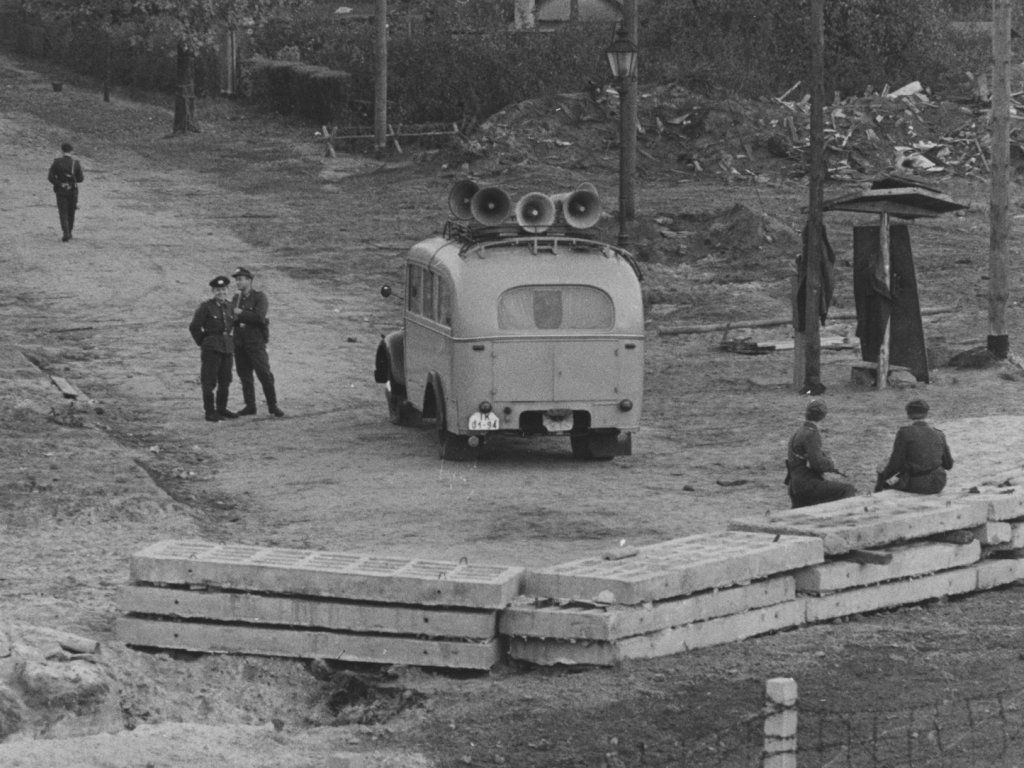
As soon as volume exceeds 80db, blood pressure rises. The stomach and intestine operate more slowly, the pupils become larger, and the skin gets paler—no matter whether the noise is found pleasant or disruptive, or is not even consciously perceived […] when millions of young people hear excessively loud music they register: danger. They become alarmed. — Joachim Ernst-Berendt, quoted in Sonic Warfare: Sound, Affect and the Ecology of Fear.
Unsurprisingly, given its relative obscurity, our search to find out more about soundcheck was tricky. We had noticed that the sound systems nearly always had telephone numbers painted on them and were all seemingly for hire. In fact, the same ones seen playing the brutalist-sirencore tracks (almost always to all male crowds) could also be seen providing entertainment at weddings or religious celebrations, where the demographic of the crowd would be much more diverse and the music being played much less challenging.
We began to contact DJs and entered WhatsApp group chats of soundcheck enthusiasts—the majority of whom were (as far as we could see) located in West Bengal—and clumsily made attempts to converse in Bangla, Hindi, and Konkani using Google Translate. We were occasionally offered a few lines responding to our questions, but invariably we were either ignored or (understandably) teased.
As our frustration was mounting at the scenes’ apparent impenetrability, and having contacted myriad Bengali cultural centers in the UK with hopes of finding a translator, we fortuitously came across Sonic Street Technologies, an ongoing research project headed by Julian Henriques operating out of Goldsmiths University in London. We were put into contact with one of their research assistants, Aadita Chaudhury, who is based in Toronto but was actually in West Bengal at the time of our call, and who was already more than familiar with soundcheck competitions.

Aadita Chaudhury: The sound systems that you’re seeing are called music boxes here. The form that you’re seeing—the competitions where they face off against each other—is new, but the ethos is not, and it actually has extremely traditional purposes. A lot of the sound systems are small businesses that rent out their equipment for certain, mostly religious, functions.
[In Indian Hindu practice,] there are specific local deities that initially weren’t part of mainstream Hinduism. Each neighborhood would have its own idol to worship during specific festival days. So, for a few days, you would have people making makeshift temples called pandals. The money needed to make these, generally speaking, comes from everybody, so they’re considered public events. They are like a third space* for people, right? And your neighborhood’s pandal is in unofficial competition with other neighborhoods’ and so, as the pandals compete, so do the sound systems. It’s like if a bunch of villages were competing with each other about who’s got the best Christmas nativity scene and they had a sound system to promote that. You would ask the local sound guy to blare music so people would come and visit.
Originally the way the music systems were developed was to serve these religious functions and weddings. Electronic music started becoming more popular and this equipment is just sitting around waiting to be hired outside of the festival seasons. You get people starting competitions because they live in places that have nothing going on.
Y7: This makes so much sense because boredom is such a powerful cultural force. This is the stuff that Mark Fisher spoke about: “No one is bored, everything is boring.” The slogans of punk were about boredom, and we generally don’t have that in the West anymore. It makes sense that soundcheck would develop in rural places where boredom presumably still exists.
AC: In the past, there have been ideas about rural India being the backwaters where everybody’s starving to death. That isn’t really the case anymore. They have a little bit more free time. They’re still economically trapped but it’s not terrible. And now they have access to iPhones and things like that.
I think “endcore” is very relevant because we’re seeing an end to earlier forms of society and a move to a more neoliberal frontier, where multiple tech giants and transnational extractive companies are trying to replace other forms of social space—the third space—and these pillars in Indian society, which impacts rural life in very specific ways. So, it is an apocalypse of sorts, and it is the end times for certain expectations of mutuality and care.
Y7: Is this comparable to the 1980s in the West? The Reagan-Thatcher era?
AC: Yeah, exactly. It‘s the height of neoliberalism in India and a lot of public lands and resources are being channeled for private gains. The motto of the Modi government in India is Atmanirbhar Bharat, which means self-sufficient India, and this coincides with cutting back on public services.
Y7: Soundcheck is a really distinct sounding style. What are your thoughts on how that has developed?
AC: They’re not professional and a lot of the remixes are just some kid on YouTube trying to use free software to make something really loud. They’re not really serious musicians by any means.
Y7: Is there an awareness of how distinct the sounds in these tracks are? Do you think there is an awareness in the context of EDM globally that this is a very…
AC: I don’t think they’re reading Resident Advisor. This isn’t something that people do professionally, this is just something that has emerged as a pastime in the last ten years. They’re not reading Pitchfork to get the latest on the sonic frontiers of EDM.
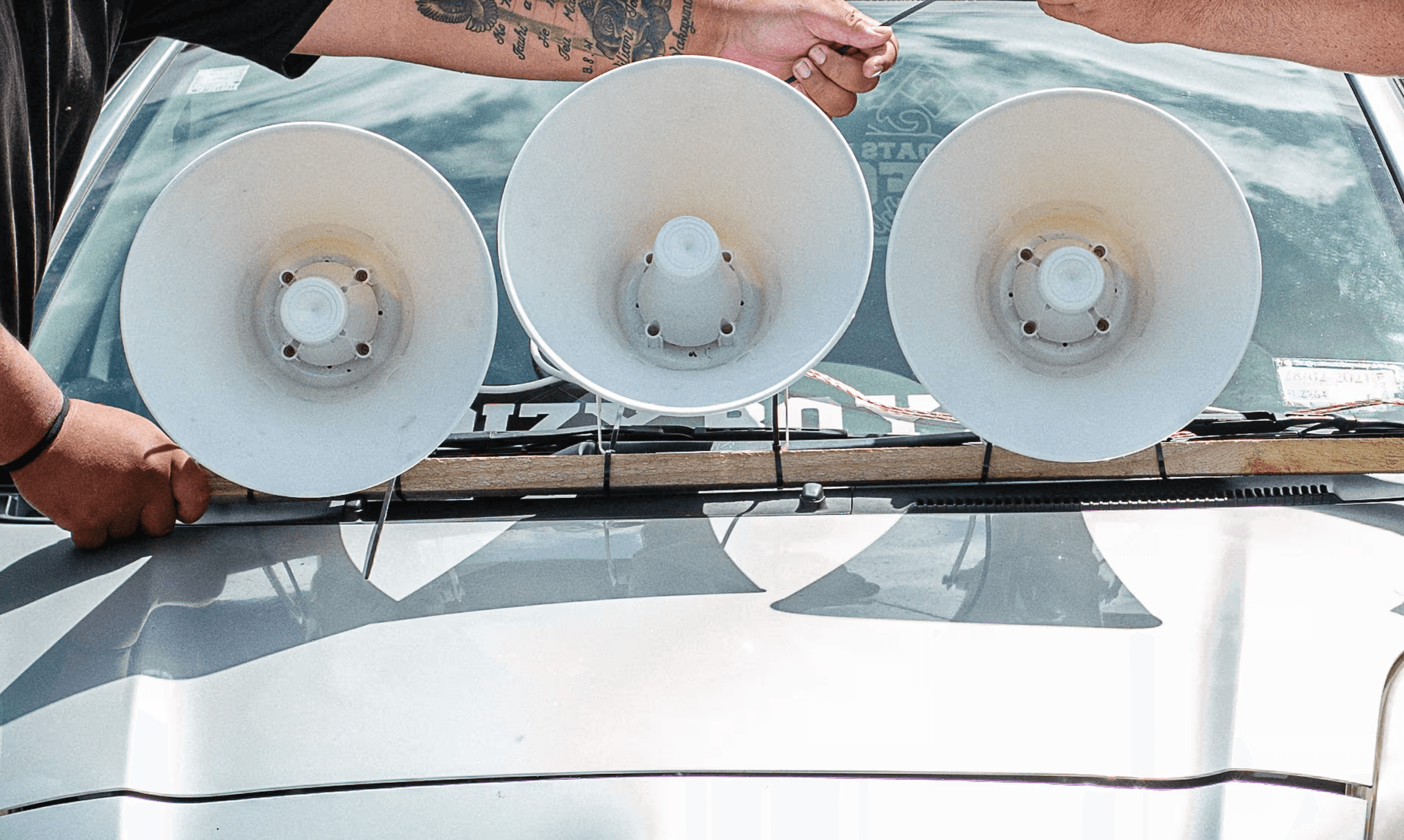
Y7: Do you personally find soundcheck exciting or do you just think it’s quite funny that we find it exciting?
AC: I mean, for me, it’s a thing that happens. If I were to ask you: Are you extremely excited about Cornish clotted cream? Is that something that you think about a lot? Are you excited about marmite?
I do think it’s interesting to see how people are observing these trends as part of a global network of sonic interventions. There’s something emerging that is not just loud music with very fast beats. There is a creativity emerging within the scene, but it’s not fully legible yet.
Y7: You’ve said that it’s quite hard to explain the particularities of West Bengal if you’re not from there, but is there any way you could try and describe some of the perceived stereotypes we might come across of the people involved in these sound systems?
AC: People might say they’re uneducated, that they’re not doing much with their lives. Not necessarily slackers but people who aren’t trying to make big things happen: unambitious townies with nothing else to do.
It’s the guy who rides his motorcycle and listens to loud music. It’s a “bad boy” type of thing to do, but these guys are also kind of wholesome and you can rely on them. They all live with their families is what I’m trying to say.
This isn’t something that people do full-time unless they own the sound system that is hired out. Soundcheck is secondary to the more traditional functions it has historically served and still contemporarily serves.
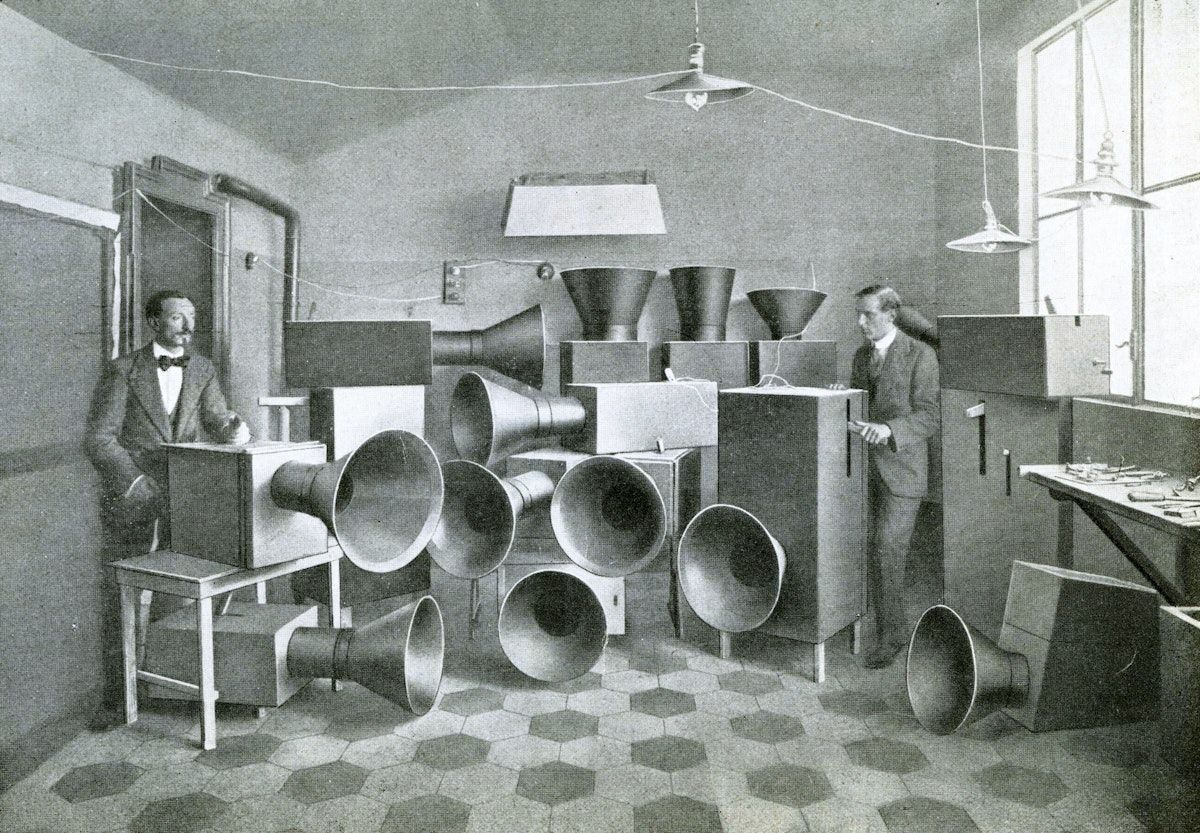
Through Sonic Street Technologies we also became aware of Roy Dipankar, an ethnographer and filmmaker, who has written for SST’s blog about his documentary Sound System Sanskriti, which looks at sound system culture in India that is more directly linked to the Jamaican tradition, centering around the “pro-initiator, selekta & radio host” Dakta Dub. Roy kindly answered some of our questions via email that both corroborated and elaborated on Aadita’s account.
Y7: When would you say that soundcheck culture, as it appears today, began? The oldest videos we have come across seem to be around five to seven years old.
Roy Dipankar: Soundcheck culture goes as far back as I can remember, every religious event [involved] loudspeakers blaring songs of a king’s valor or a God’s wrath; of human redemption, a devotional-mythological melee of songs. Stand-offs would often occur between pandals. I have passed through villages near my wife’s ancestral land (which is semi-rural) and I have seen standoffs occur, and I never could really comprehend the motives behind them. The videos that you see on YouTube today are five to seven years old because that is the exact timeline of when smart phones, the internet, and social media penetrated rural India.
Y7: Are we correct in interpreting that the roadshows and competitions are to “show off” the sound systems with a view to them being hired? The tracks sound like they are designed to test the limits of both the speakers and the attendees’ ears.
RD: To an extent it is true. I would also add that the real reason for the “roadshows” with sound systems is probably to create an awareness of why the roadshow is being held in the first place, which could be any number of things: adverts; election results, sports results, “wealthy” weddings.
Finally, we asked Roy if there was much of a direct influence from Jamaican sound system culture on soundcheck. He explained that there is more of a focus on fidelity with the former, that there will be tests and tunings to try and achieve “the perfect pre-amp settings, accurate resonance, and hog scoop calibrations” and that generally “such meticulous detailing is missing with the local sound systems.”
Diminished intellectual capacity, accelerated respiration and heartbeat, hypertension, slowed digestion, neurosis, altered diction: these are the consequences of excessive sound in the environment. — Jacques Attali, Noise.
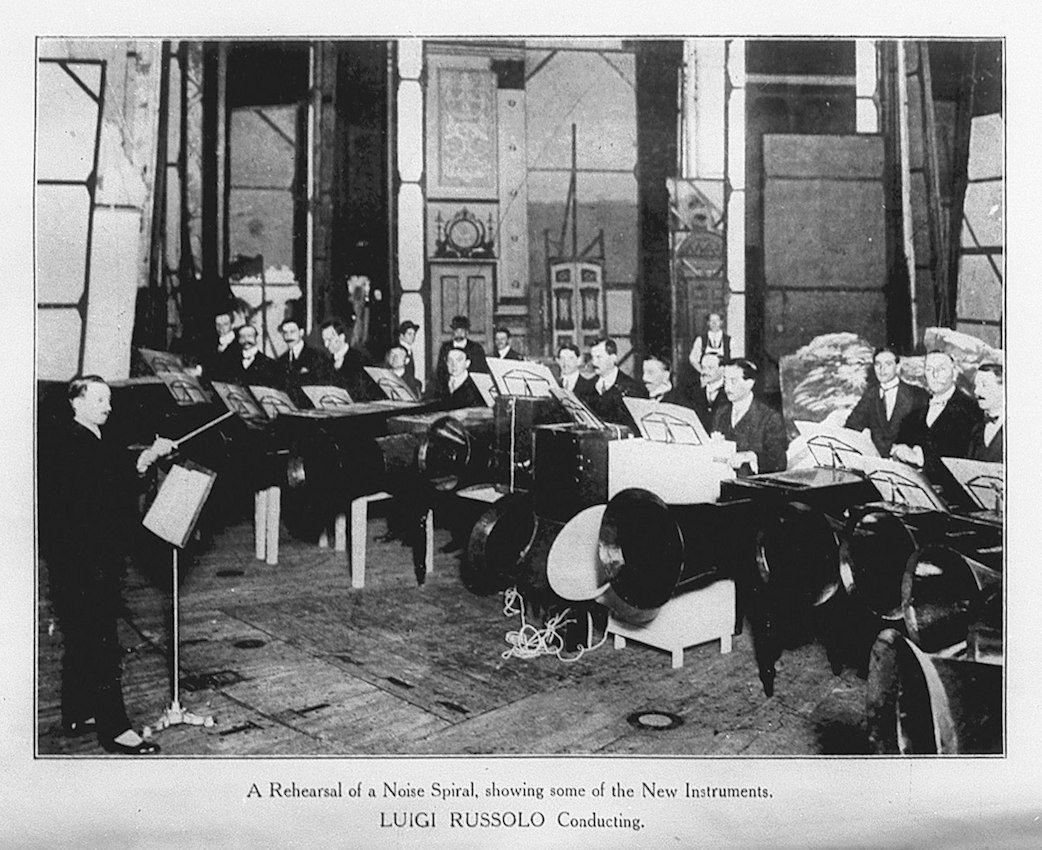
The prospects for the conditions that gave rise to soundcheck (spare time, communality) under a program of aggressive neoliberalism are evidently not favorable, and how this will impact the progression of the scene remains to be seen. There has been much written about the erasure of these forms of time and spaces in the West and how they have detrimentally impacted cultural production, and it is not the purpose of this article to reiterate these arguments nor to transpose or project them onto a possible future progression for Indian musical culture, primarily because we are not remotely equipped nor qualified to do so. Suffice to say, we expect that many reading this article will recognize that boredom is a distant memory—or worse, a foreign concept.
Much like the ‘Siren Battles’ in New Zealand, it is likely that noise pollution and the politics of noise will increasingly become determining factors in soundcheck culture. In his aforementioned documentary, Roy Dipankar outlined that the Jamaican-style sound systems in India are subject to stymieing bureaucratic processes: firstly, because they tend to take place in more urban areas where restrictions on noise are more acute, and secondly because the traditional cultural associations of soundcheck competitions are much more conducive to, in Roy’s words, “the right-wing shift in Indian political and social fiber” compared to outfits like Dakta Dub’s Monkey Sound System, which evoke much less respectable social associations in the eyes of the authorities, particularly regarding the presumption that any sound system in the Jamaican tradition will bring with it the use of marijuana. But one might imagine that if soundcheck’s popularity increases (and it already attracts sizeable crowds and gatherings) then it too will begin to face similar restrictions.
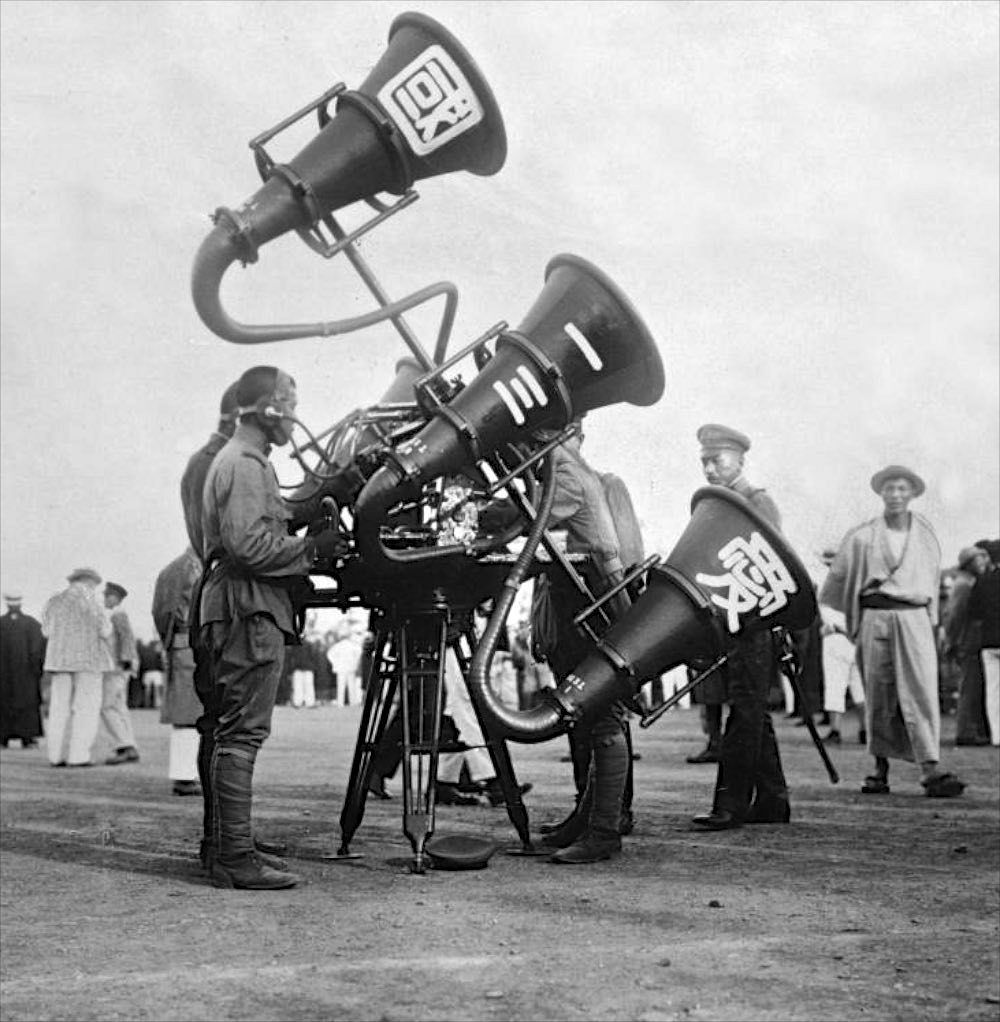
Soundcheck’s deployment of audio’s loudness as a primary qualitative attribute equal to more stylistic qualities has a few notable parallels. One of the most immediate links to be made is the sound systems’ similarities to various tools of sonic warfare, particularly Long Range Acoustic Hailing Devices (or LRADs), which have been widely used in many countries for the rather ironic purposes of crowd dispersal. In addition to this, the visual ostentatiousness of the sound systems (particularly those of a rickshaw variety) are reminiscent to us of images of Japanese War Tubas, which were a variety of acoustic locator used by the Imperial Japanese Army in both World Wars, and it is in fact roughly this same time period where soundcheck can find many of its predecessors in the West. In 1913, Luigi Russolo’s seminal text The Art of Noises advocated jailbreaking music from its confines of orchestral instrumentation and the well-trodden paths of scales and standards, preferring instead to look to a rewilding of sound into noises more befitting of the machine age. A similar heroism of industry and noise can be found in Arseny Avraamov’s elaborate 1922 sound work Symphony of Sirens; a city-wide symphony composed of “choirs thousands strong, foghorns from the entire Caspian flotilla, two artillery batteries, several full infantry regiments, hydroplanes, twenty-five steam locomotives and all the factory sirens in the city.”
These concerted interventions to reorient sound from the perceived restrictions of music is where our conversation with Stefanie Egedy begins. Her practice approaches the vibrational tactility of sound as equal to the more typical considerations of how sound sounds. The very real (and very powerful) physicality of sound is, we feel, an undermined area of creativity that Stefanie and artists such as Mark Bain, Joana Burd, Steve Goodman, and Nik Nowak are doing crucial work in. More widely, this area of study incorporates and encourages trans-sensorial approaches to creation, such as those found in the work of artists such as Christine Sun Kim, who, as a Deaf artist uses sound from a stance of assumed preclusion, much in a similar way to the unconventional methods Wanda Díaz-Merced adopts to undertake her research as a blind astronomer.
We wanted to explore with Stefanie the links between her ongoing major project “Bodies and Subwoofers (B.A.S.)” and soundcheck competitions. As suggested by the title, “B.A.S.” directly considers bodily experience in relation to sound, and we began by discussing how this might relate to conceptions of meter, rhythm, and time.
The future’s already assembled, but not by design. Sub-bass materialist concurrence emerging out of order. —Swarmachines Rewind.
Y7: The compositions you make seem to be arrhythmic, perhaps more in the lineage of drone, or could be better described with words such as pulses and waves. Would you say this is directly related to the rhythms, pulses, or cycles of the body?
STEFANIE EGEDY: Rhythm in “B.A.S.” is not always there in a very clear way, in comparison to how you would perceive it in dance music, for example. When I play Berghain or Robert Johnson, I like to implement more rhythmic patterns almost as a kind of reference, and then break it. But when I’m working in the middle of nature, such a rhythm seems out of place. I’m trying to tap into a score that will invite bodies to stay in that space and interact with the sound. I consider “B.A.S.” to be site-specific sound design combined with acoustic interaction. I’m interested in being able to have all sorts of people experience low frequencies.
Y7: Do you have a range of frequencies you deem as sub-bass that you work within?
SE: I consider it to be 20 to 63 Hz. But also, normally, if I have the right subwoofer, I prefer not to go above 39 Hz. I often work just from 27 to 39 Hz because that’s the range where I get a transparent sound. I still get a sort of tonality, but it’s a tonality of transparency. If I go above 39 or 40 Hz, I start to get a more present tonality on a higher frequency pitch, which I don’t really want. I want it to almost be a transparent force, this thing that you don’t really listen to directly; rather you listen to it interacting with the walls… you feel it, it’s present, it’s there. There are so many possibilities between 27 and 39 Hz. I have a custom-built device that my friend developed which allows me to micro-tune between Hz and it’s opening up new possibilities of composition.
Y7: What’s striking is your use of terms such as “transparency” and “massage,” to accommodate the idea that it’s not just about hearing, but also about feeling.
SE: Totally. Because of the specificity of the technical procedures that I do, I get an unusual type of sound that you’ve probably never really experienced before, and this is in large part down to the technology I use. It’s a really important aspect of my work. I prefer to work with SL-SUBs by d&b, as there’s a certain timbre to the sound they create that fits well with my work.
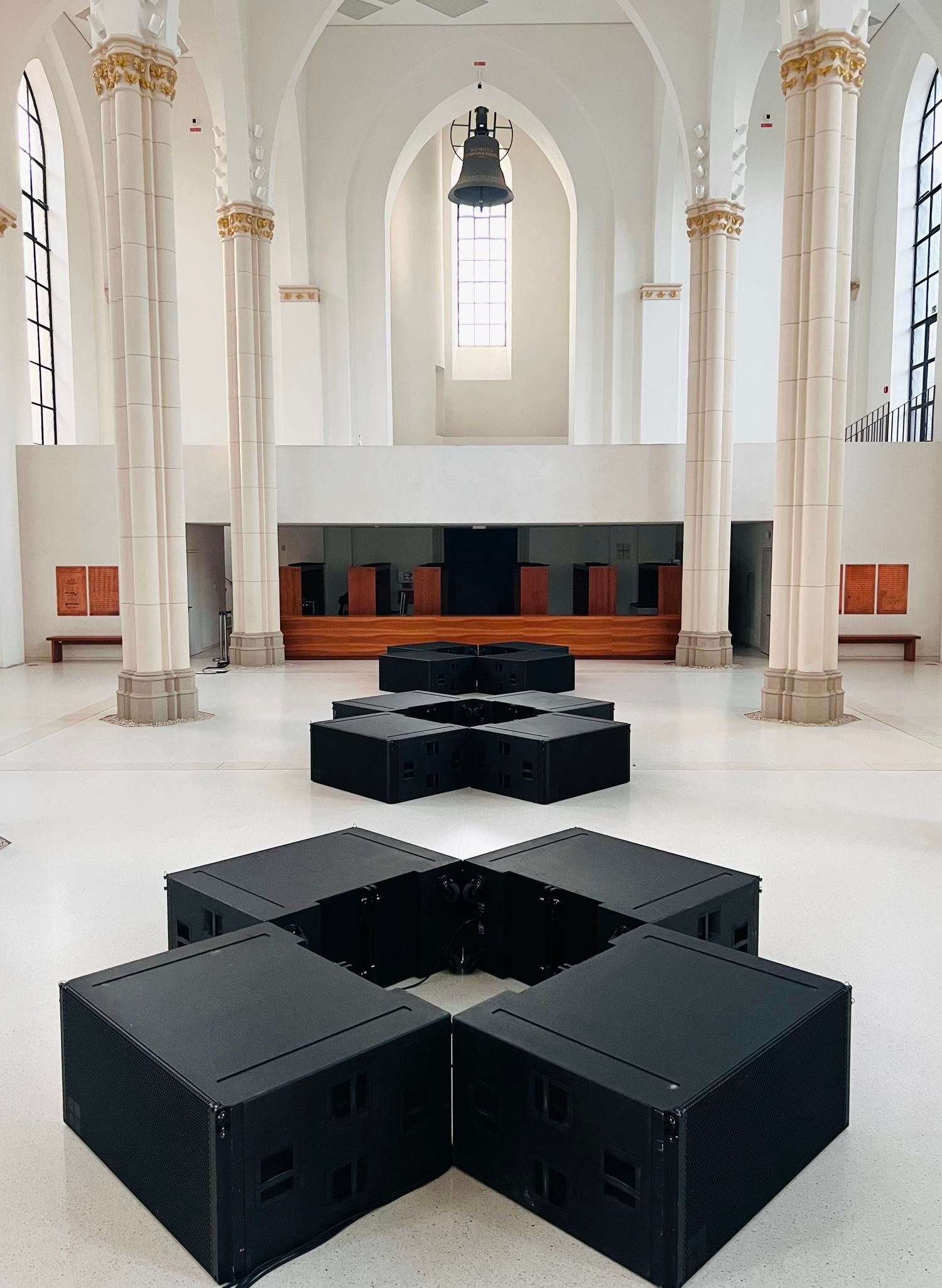
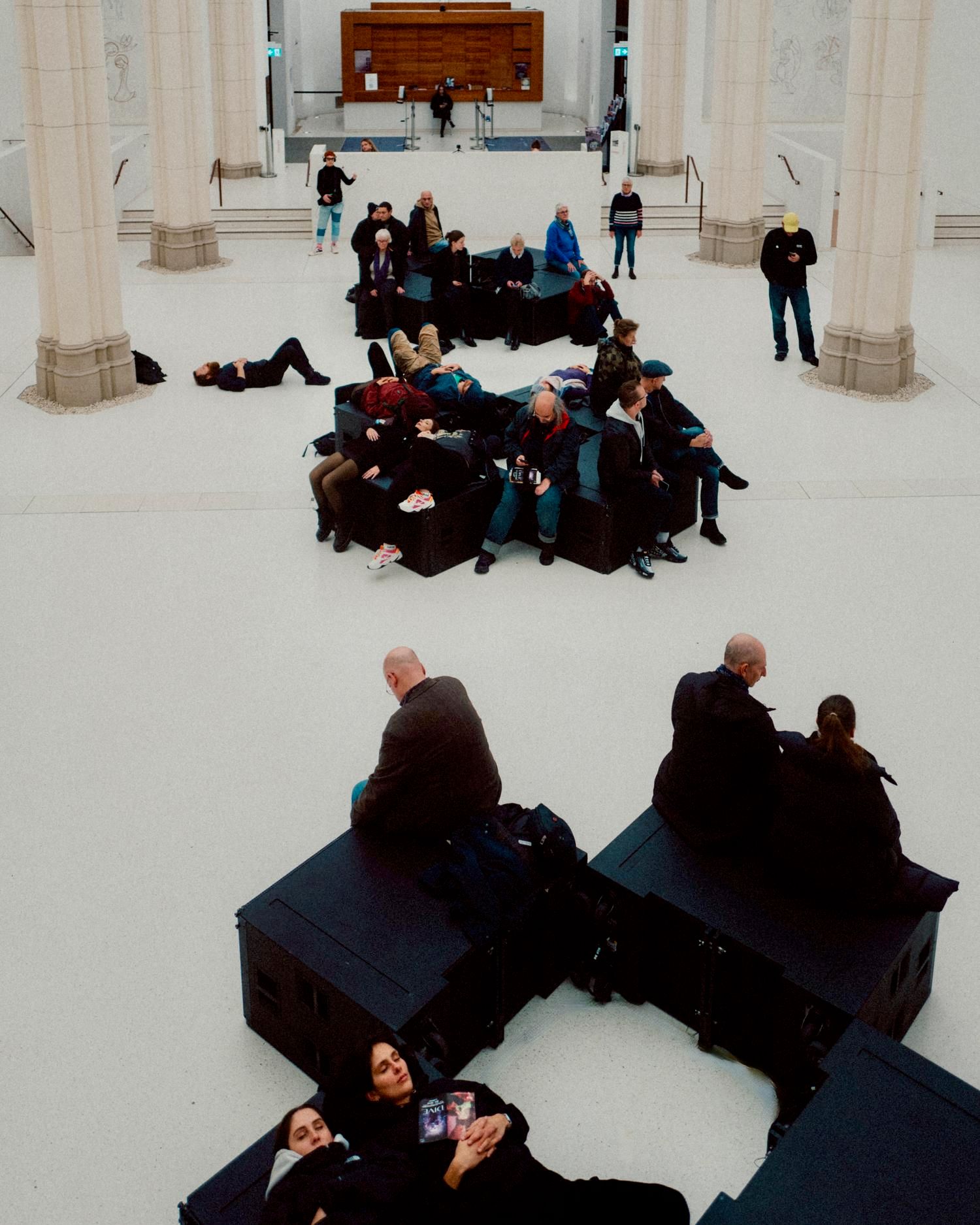
Y7: When we first came across the NYFW incident on TikTok, we were blown away. Are we correct in thinking it was a rehearsal that set off the alarm for a nearby building?
SE: It was the soundcheck for a performance by Alexis Blake, titled “Crack Nerve Boogie Swerve” in which I am the low frequency sound and subwoofer artist. There were no restrictions, so I put on a 30 Hz piece which I generally use to sound check. I wanted to know how loud I could go—what would the loudest setting sound and feel like? That’s what I did for five to ten minutes and everyone was enjoying it, and I was enjoying watching the reactions of people who had never experienced subwoofers like this.
Then, apparently the Alice and Olivia team—who were doing their preparation for NYFW above us —didn’t see the email saying that there would be a soundcheck with low frequencies. So that’s how everything happened. They thought it was an earthquake or a gas explosion.
I really appreciate how low frequencies can reach places beyond the work itself. On a conceptual level, I find that fascinating because it’s crossing borders. A part of our society is so boxed off and I like that sound can disrupt a bit of the box.
Y7: We’re dying to know your thoughts on the sound systems in India. Had you come across them before?
SE: I hadn’t and I loved it. At first it reminded me of when I was a kid, and I had a studio at home. My brother was trying to study in the living room and was annoyed with a sound I was making, and then we started a sound war.
But I loved it, I was like, “Oh my god, they are all going to have serious tinnitus, are they aware of that?” It’s clear that it’s not a healthy listening experience, but aren’t we always looking for this sort of danger? It intrigues me how we can be driven towards unhealthy, dangerous experiences. Maybe some people work from ten to six and they go to the gym and eat super healthy, but then on the weekends, they get wasted. I think it’s just another way of challenging our bodies.
I would agree with the idea that it’s part of “post-music” and that we are slowly transitioning, but perhaps people who study theory can look at it like that, I just wonder if the people making soundcheck are studying the same theory? Do they have a concept of sound art, and is it similar to ours? What do they think about sound beyond music?
Y7: How would you define the difference between sound art and music?
SE: I wouldn’t say you can completely separate them. At least with how I observe the world, I would say that now I’m listening to my heater and I have this drone-y thing, but I can identify a pattern in the drone where there are moments of higher tones and then lower tones—it’s minimal music to me. So, you can always observe some formal musical aspects in sound, if you want. You can always draw a line. You can always find a pattern, it’s about the way you listen.
I believe that if sound cannot fully remove itself from music, then perhaps sound art is an attempt to use sound beyond music, and what is music at the end of the day? If it’s a song that you listen to in your domestic sound system or from a musician in a venue, then somehow music is boxed off. Whereas sound, you can do sound artwork in whatever type of place or context. It’s beyond this musical ecosystem and its expectations—it’s more free, I would say.
Unsound—the not yet audible. Refers to the fuzzy periphery of auditory perception, where sound is inaudible but still produces neuroaffects or physiological resonances. Refers also to the untapped potential of audible bandwidths and the immanent futurity of music. Sonic virtuality. — Steve Goodman, Sonic Warfare: Sound, Affect and the Ecology of Fear.
It is difficult to navigate discussions on the utility of sound or of sound-as-vibration without steering dangerously close to the semantically bleached rhetoric of New Age practices. But, as Erik Davis brilliantly outlines in his essay “A Brief Defence of New Age Audio,” it may be an area of sonic culture that is worth a reappraisal. As already stated, a concept of post-music could center around mobilizations of sound not just determined by how sound sounds but also by what sound moves. This too is the case in New Age music, where frequencies are purported to activate real life consequences. As Davis himself states:
New Age music declares and deploys itself on […] a psychoacoustic or subliminal domain of vibrational control over hidden, unconscious, and sometimes mystical systems of the human bodymind. In other words, composers intentionally and sometimes explicitly present their music as an apparatus for directly operating on the expanded psycho-bio-cosmic systems that are ‘running’ the programs of conscious awareness. Whether or not this self-presentation is merely rhetorical, New Age music should still be seen [in] part as a kind of utopian or idealist posthumanism, in which audio is optimistically deployed and consumed beyond the limitations of the personal listening subject.
So, whether that’s by tuning in to a frequency that will attract wealth, encourage healing, or even turn you into a sexual beast, New Age practices congregate around notions of an effective mobilization of sound that move past traditional listening practices. But what if we were to strip this idea of the self-serving pseudo-science it relies on and redirect it towards the very real material effects of sound?
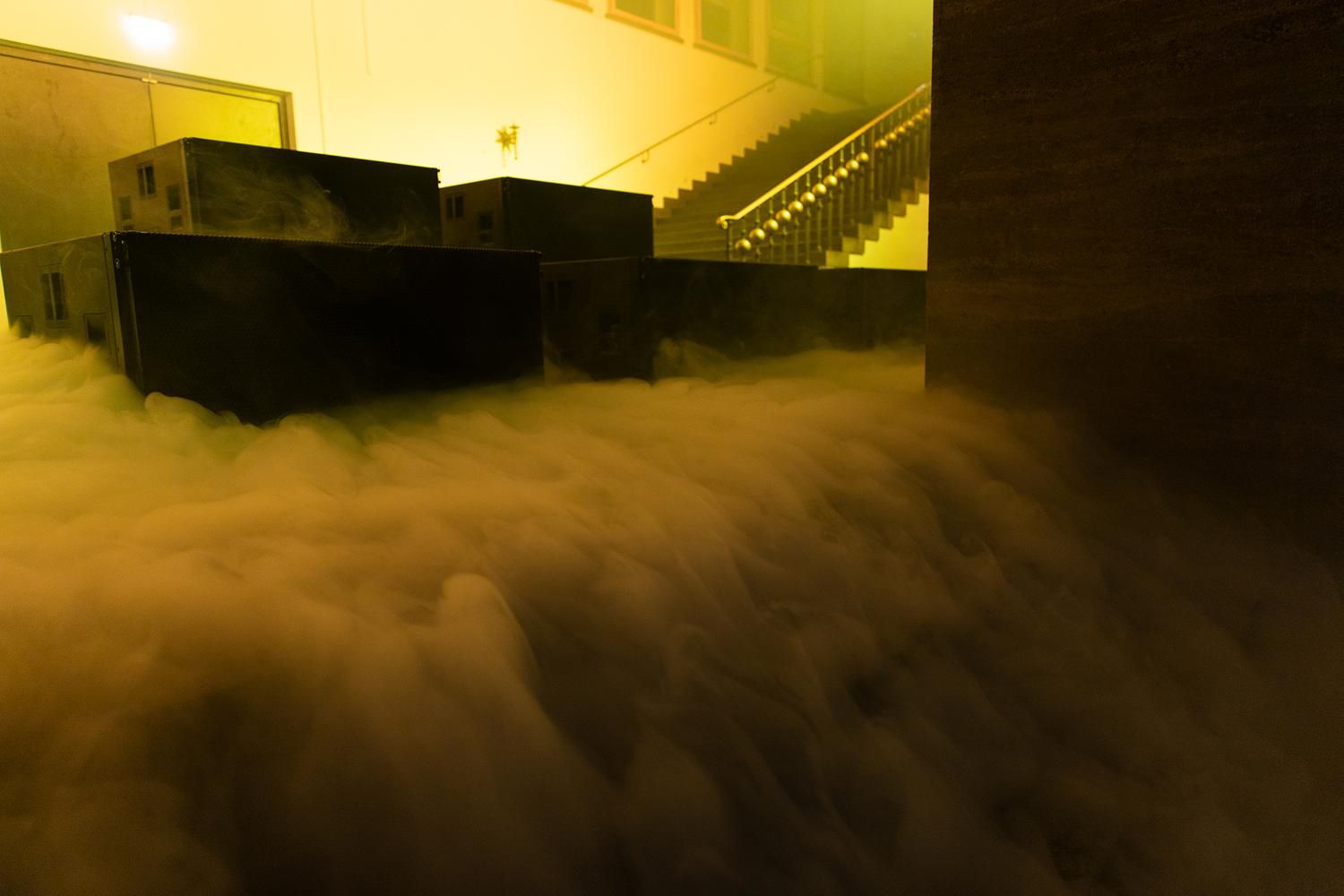
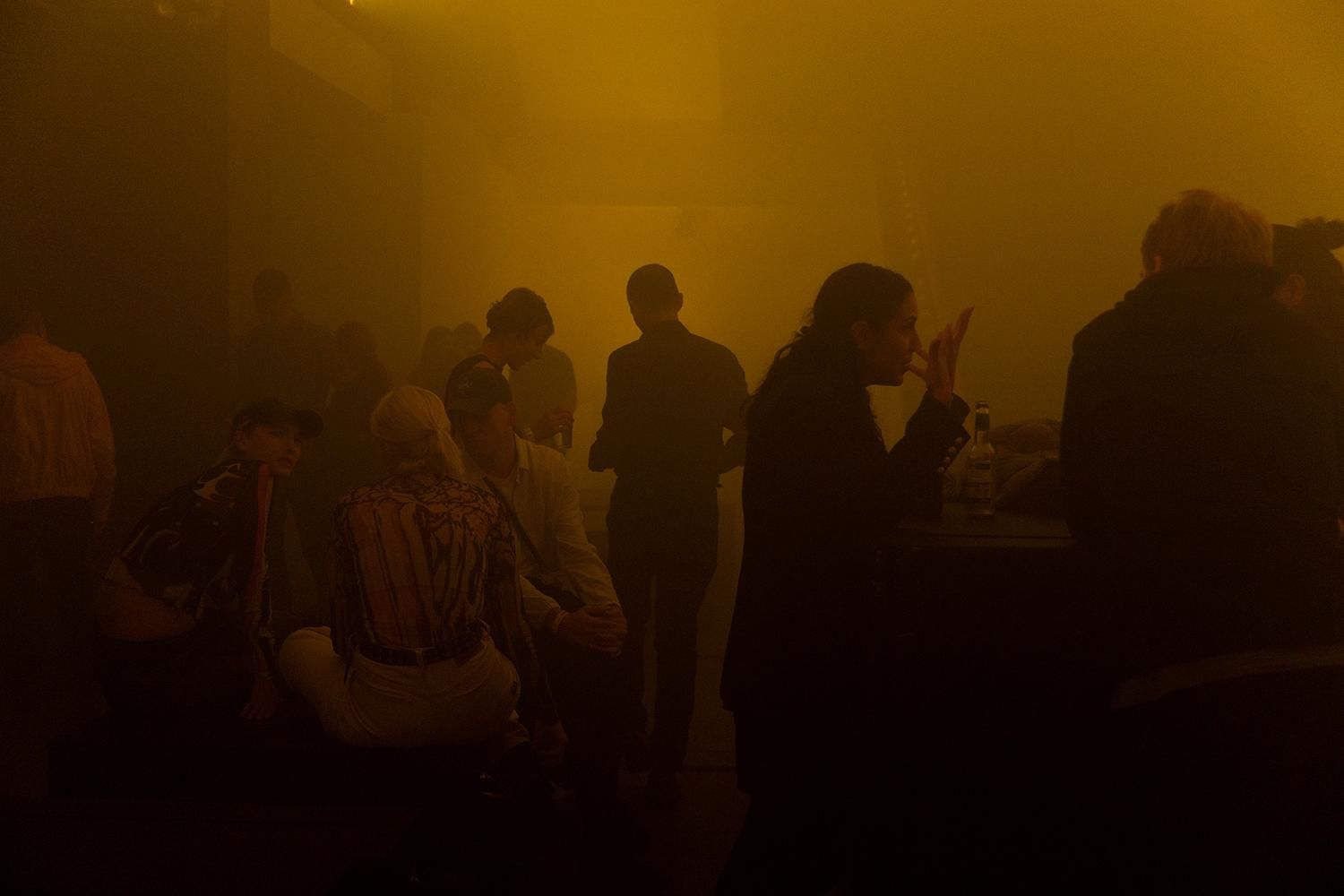
“B.A.S.” and soundcheck competitions clearly overlap with New Age practices in their use of sound in ways that moves past purely aesthetic concerns of—to paraphrase Jean-Michel Basquiat— how sound can decorate time. They also both explore how sound and bodies interact in space IRL, and it is precisely this spatial aspect that we believe will be a consistent theme in future audio cultures. A provocative precedent to these developments can be located in Ryoji Ikeda’s sound work Matrix (For An Anechoic Room). Released in 2000 on Jon Wozencroft’s Touch label, the work is part of Ikeda’s wider “Matrix” series which employs,
pure sine waves and white noises as a sculptural material […] As visitors pass through the sound field, subtle oscillation patterns occur around their ears, caused by their own movements interfering with the sounds. It is a very personal experience, and only through the visitors’ physical engagement in the sound space can the real character of the work be perceived.
When played in a suitable environment with little background noise, it feels as though the track is being beamed into your head and, as you slowly move through whichever space you are in, modulations and fluctuations of the audio are dictated by your own movement. At times it is hard to distinguish where the noise is coming from, if not from somewhere on your immediate person. In this sense it is an eerie, inverted precursor to spatial audio, which shares some attributes with soundcheck tracks in its distinct lack of allusions or metaphors: the audio (again) draws your attention only to its own immediacy.
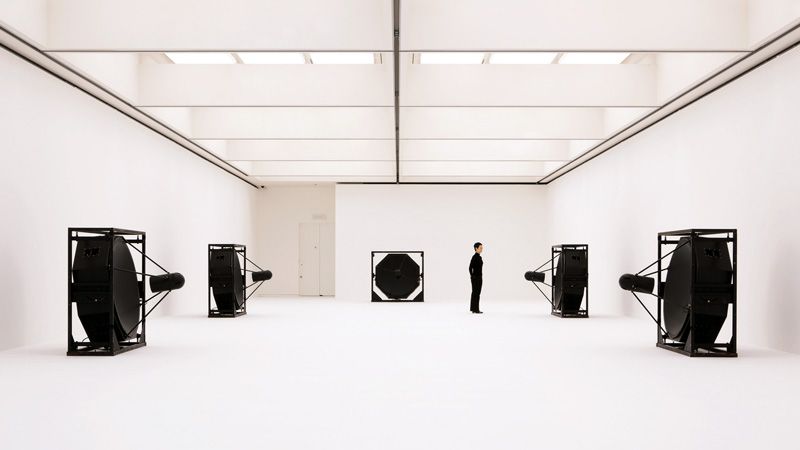
We’ve recently seen Apple Vision Pros being used in public in America, and as comical as some of the clips of them in use are, it is likely that this is an area that will continue to be developed and explored, and could prove interesting when thinking about how spatial audio might interact with a haptics of sonic tactility. So, alongside the capacity to experience spatial audio in the pressurized headspace of active noise cancellation technology, we may also find ways to externally experience a post-music landscape built around a sculptural nature of sound seemingly plucked straight from the world of J.G. Ballard.
As runaway micro-trends increasingly populate the current musical landscape with caricatured sonic aesthetics, might we see a shift towards the mobilization of sound outside of how it is heard and towards how it is experienced and felt? What, we ask, might happen when this intersects with the fidgety, accelerated methodologies of Shitpost Modernism? And further still, how might that converge with generative AI tools? With spawning and vibe sampling? Might this capacity for endless iteration render the song-as-discrete-unit redundant, opting instead for aggregated live-streamed infinity?
A post-music landscape could be one populated with hypersonic sound and directional speakers, producing fine-tuned environments that are highly targeted in both form and content. It could deploy a subversion of functional sounds, or re-engineer the memetic sophistication of audio brand idents; paradoxically synthesizing them with the formally simple, audibly loud brutalism of soundcheck practices. Indeed, the music of the future may be so loud that in order to enjoy it we have to wear industrial ear defenders and feel it move us.
* “Third places” is a term coined by sociologist Ray Oldenburg and refers to places where people spend time between home (“first place”) and work (“second place”). Some examples of these are churches, cafes, community centers, public libraries, and parks.
Credits
- Text: Y7
Related Content
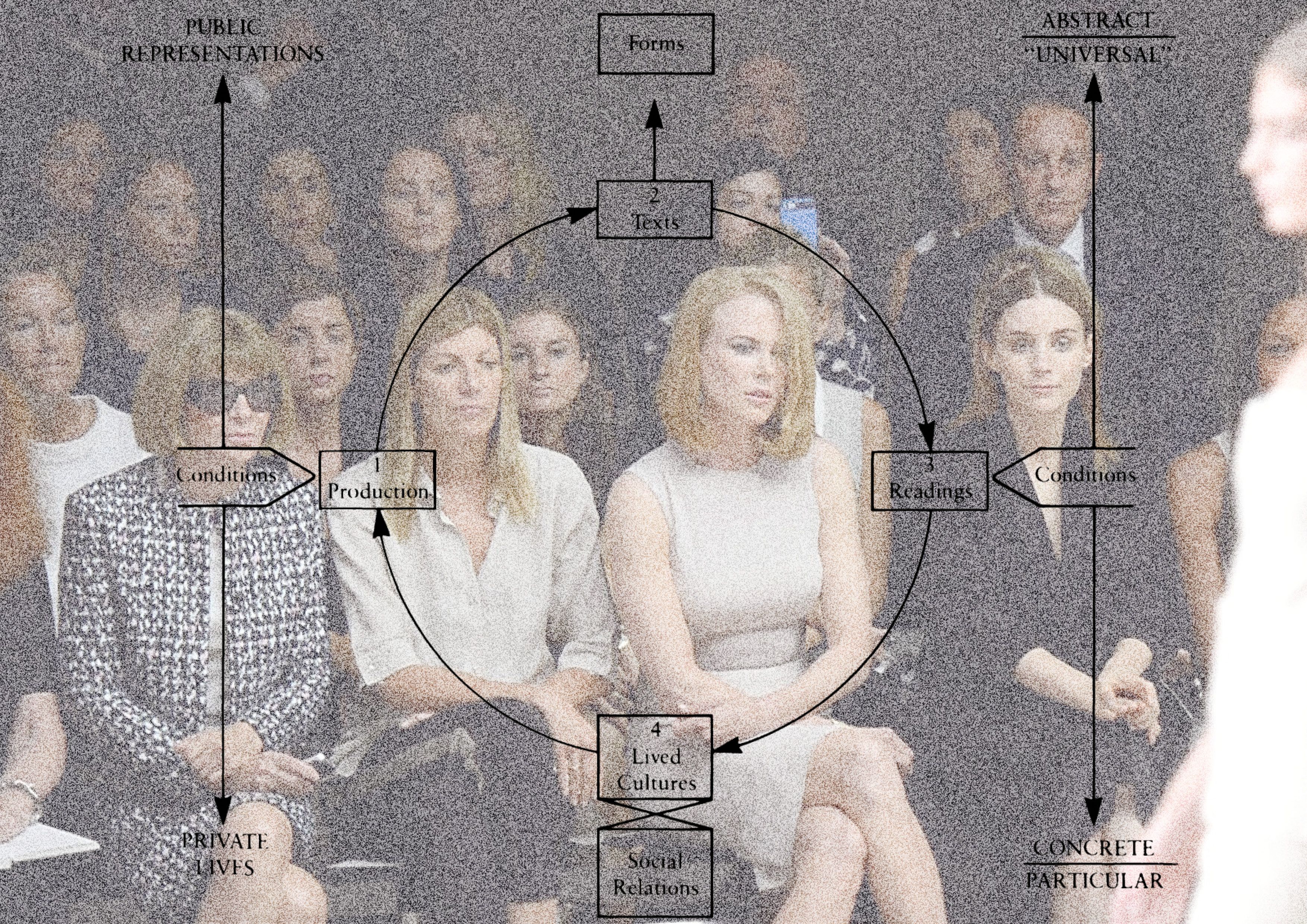
Runway Music: Musicology for Clothes

Love in the Time of Prompting: SHUMON BASAR and Y7’s CORE+LORE
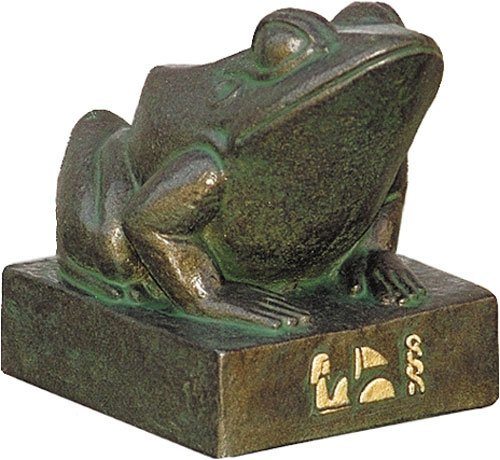
Weaponized Irony: A Roundtable on Trolling and Politics
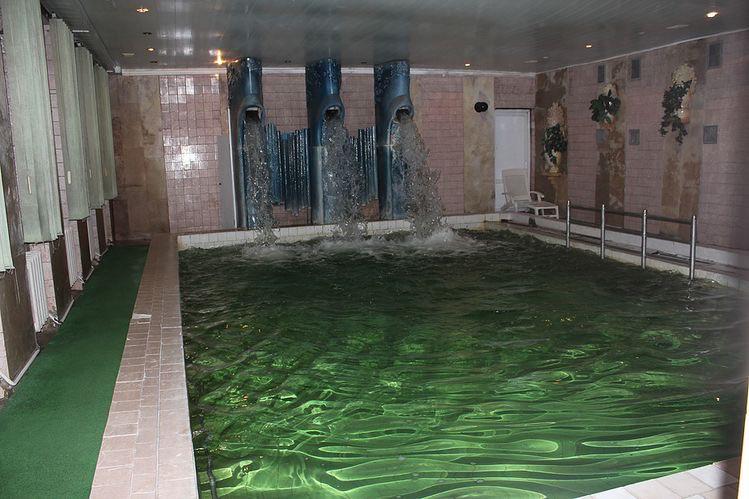
An Analysis of The Backrooms—Also Known as the Internet's Horror Rooms

Berlin’s Sonic Mecca
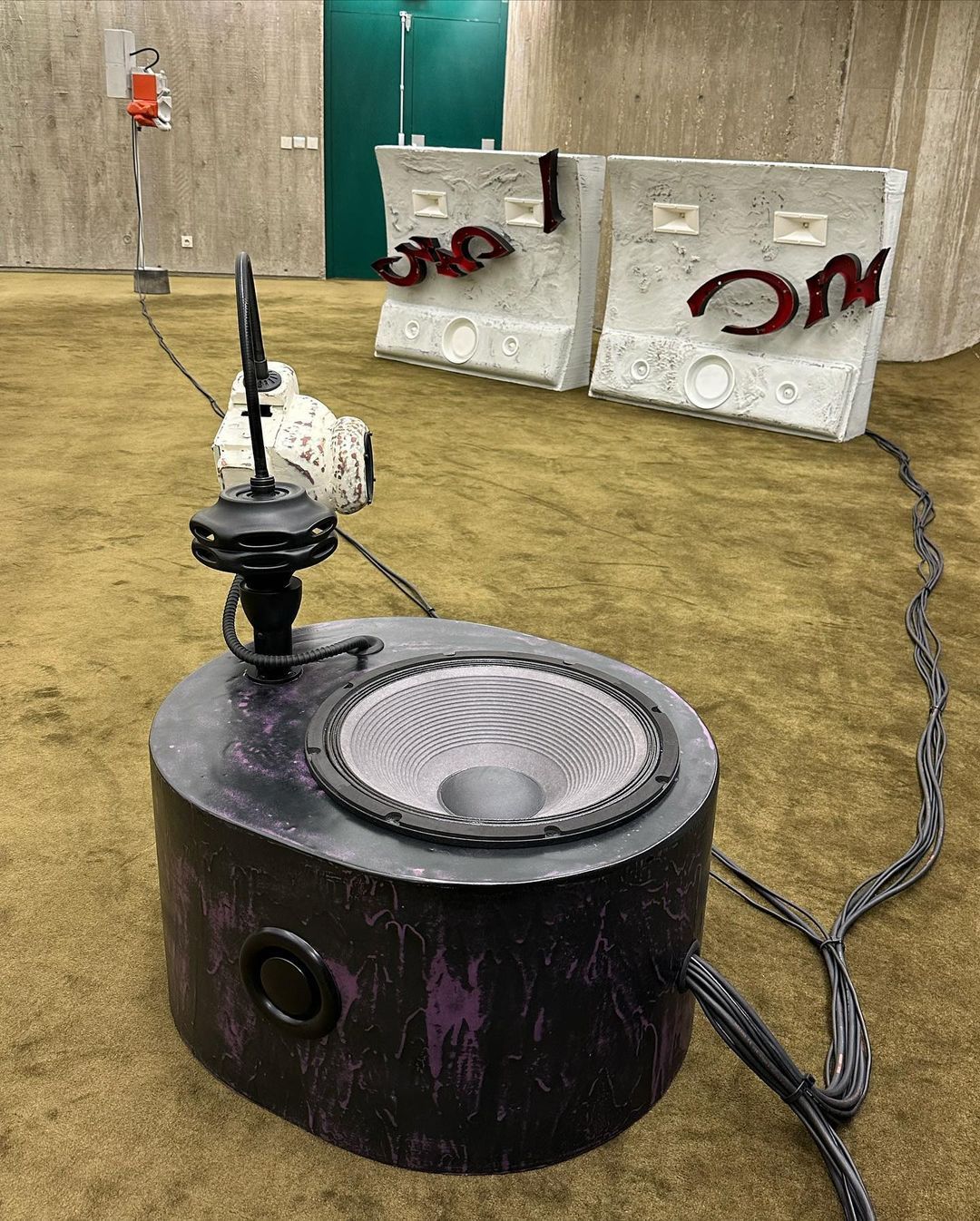
Erwan Sene’s Sonic Odyssey

Finding Romance in the Grotesque: JON RAFMAN
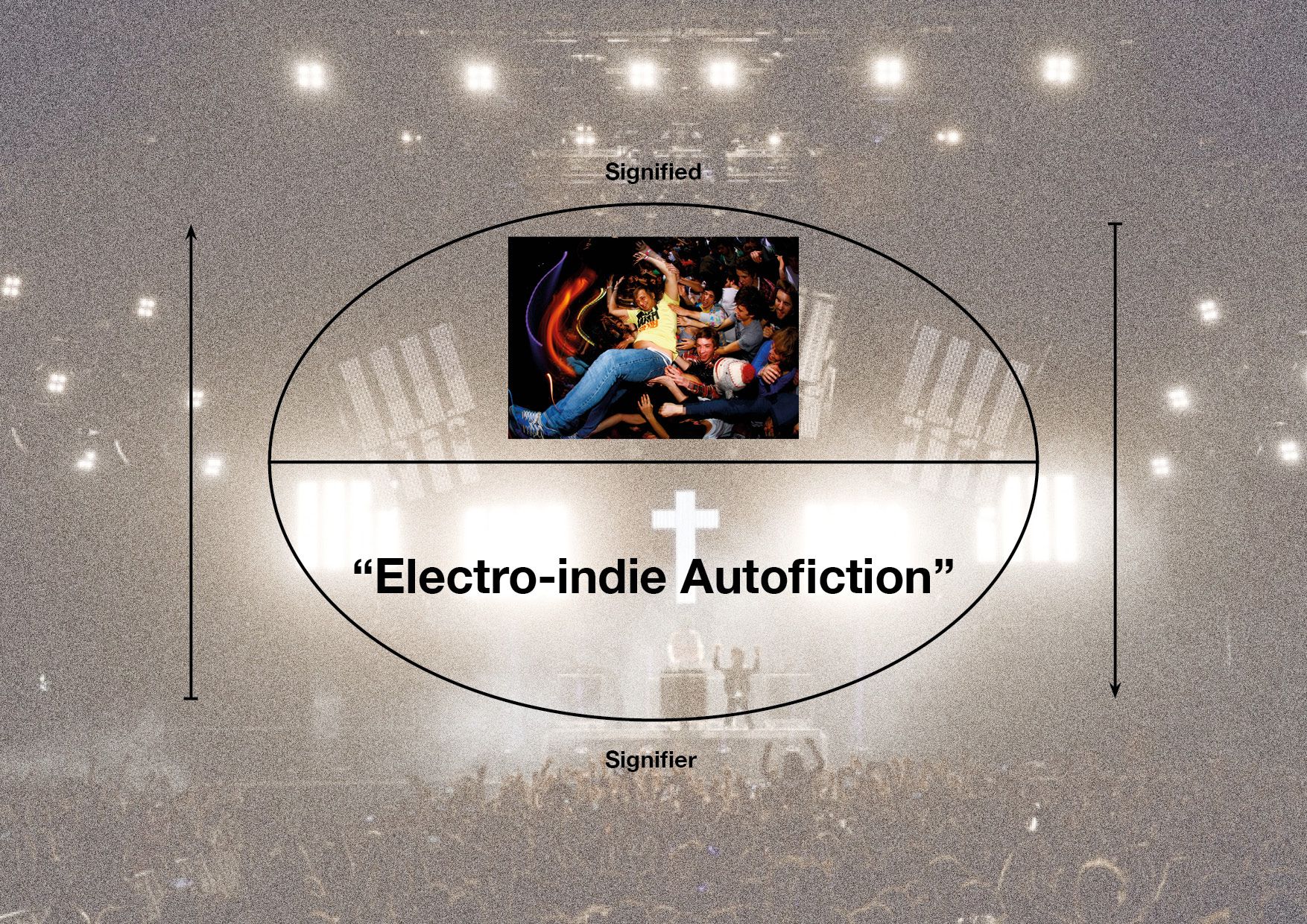
Runway Music: Electro-Indie-It-Girls